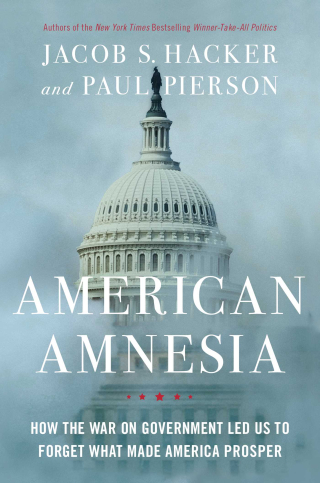
Henry Farrell in Crooked Timber:
Jacob Hacker and Paul Pierson’s new book, American Amnesia: How the War on Government Led Us to Forget What Made America Prosper does four things. First, it makes the case for the mixed economy – the effort to make the market and state work together. Second, it makes the case that mixed government existed. The US used not to be as divided as it is now, and business, rather than being committed to a virulently anti-state agenda was often relatively pragmatic. Third, it tries to explain how this went South – how mixed government, and indeed government, became a dirty word. Finally, it asks how mixed government can be resuscitated again.
Hacker and Pierson’s political argument, as I read it, has a lot in common with that of old-style liberals like J.K Galbraith and Charles Lindblom. Hacker and Pierson don’t want an overweeningly powerful state – instead, they want a state and market that work together. They borrow Lindblom’s analogy of markets working like the fingers of a hand to provide dexterity, while the state works like a thumb, to provide authority and to help grasp things that need to be grasped. This does not imply that the state and markets should be guided by a single will so much as that they work, when they work well, in complementary ways. Indeed, like both libertarians and many leftists they are highly suspicious of what might happen when the state and private industry build relations that are too congenial. As they describe it (p.5), “Democracy and the market – thumbs and fingers – have to work together, but they also need to be partly independent of each other, or the thumb will seek to provide effective counterpressure to the fingers.”
In a mixed economy, government provides services and goods that will be underprovided by the private sector, or perhaps not provided at all. It also regulates market actors, obliging them to behave more honestly towards the consumers of their products. As the economy becomes increasingly complex, it becomes increasingly easy for private sector interests to take advantage of ordinary people. Regulators can help restrain business through regulation and antitrust (Hacker and Pierson acknowledge Woodrow Wilson’s racism but have kind words for his efforts to build the institutions that would regulate market competition). Unless business is restrained by the state, it is liable to behave badly.
More here.
When I came to The Atlantic I’d been writing for 12 years. The Atlantic is seen as this arbiter of sophisticated ideas, well ensconced in the mainstream consensus, and then they bring in this dude. I wasn’t making the case for reparations back then, but I was saying that sort of shit. I could see the reaction, and it built a little bit, and then when “The Case for Reparations” came out—holy shit. But even then it was like, “This is one story, and I’ll go back to my life.” I thought Between the World and Me would hit people who read shit. When we did BookExpo America, the book-trade joint, there was a line of people to get the galleys. I was like, “What the fuck?” And I knew it was some shit when somebody said to me on Twitter, “Oh, you’ve got to be a celebrity to get this book?” [laughs] Who the fuck wants a galley? And then when you’ve gotten love from Toni Morrison—it still didn’t hit me. When I started seeing the reaction to it I thought, Oh, this is different.
